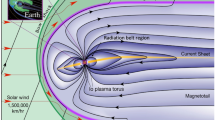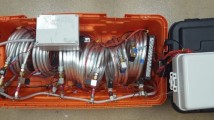Abstract
Radionuclide monitoring, though slower than vibrational methods of explosion detection, provides a basic and certain component of Comprehensive Test Ban treaty (CTBT) verification. Measurement of aerosol radioactive debris, specifically a suite of short-lived fission products, gives high confidence that a nuclear weapon has been detonated in or vented to the atmosphere. The variable nature of wind-borne transport of the debris requires that many monitoring stations cover the globe to insure a high degree of confidence that tests which vent to the atmosphere will be detected within a reasonable time period. To fulfill the CTBT aerosol measurement requirements, a system has been developed at PNNL to automatically collect and measure radioactive aerosol debris, then communicate spectral data to a central data center. This development has proceeded through several design iterations which began with sufficient measurement capability (<30 μBq/m3 140Ba) and resulted in a system with a minimal footprint (1 m×2 m), minimal power requirement (1600W), and support of network infrastructure needs. The Mark IV prototype (Fig. 1) is currently the subject of an Air Force procurement with private industry to partially fulfill US treaty obligations under the CTBT. It is planned that the system will be available for purchase from a manufacturer in late 1997.
Similar content being viewed by others
References
T. W. Bowyer, K. H. Abel, C. W. Hubbard, A. D. McKinnon, M. E. Panisko, R. W. Perkins, P. L. Reeder, R. C. Thompson, R. A. Warner, J. Radioanal. Nucl. Chem., 235 (1998) 77.
W. K. Hensley, E. A. Lepel, M. E. Yuly, K. H. Abel, J. Radioanal. Nucl. Chem., 124 (1988) 481.
L. A. Currie, Anal. Chem., 40 (1968) 586.
A. D. McKinnon, S. M. Bowyer, C. W. Hubbard, H. S. Miley, R. W. Perkins, R. C. Thompson, R. A. Warner, J. Radioanal. Nucl. Chem., 235 (1998) 115.
S. M. Bowyer, D. C. Gerlach, M. J. Kniedler, H. S. Miley, S. L. Pratt, C. W. Thomas, J. F. Wacker, J. Radioanal. Nucl. Chem., 235 (1998) 121.
C. W. Hubbard, A. D. McKinnon, Trans. Nucl. Sci., 44 (1997) 783;A. D. McKinnon, C. W. Hubbard, Trans. Nucl. Sci., 44 (1997) 1062.
Author information
Authors and Affiliations
Rights and permissions
About this article
Cite this article
Miley, H.S., Bowyer, S.M., Hubbard, C.W. et al. A description of the DOE Radionuclide Aerosol Sampler/Analyzer for the Comprehensive Test Ban Treaty. J Radioanal Nucl Chem 235, 83–87 (1998). https://doi.org/10.1007/BF02385942
Received:
Issue Date:
DOI: https://doi.org/10.1007/BF02385942




